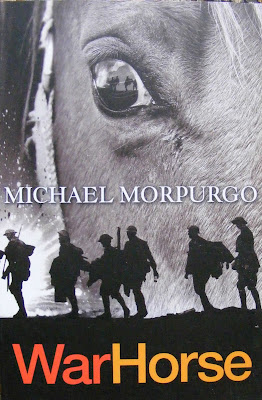PBOTD 5th April: Enid Bagnold - National Velvet
My senior school had a book shop. The books lived in a locked wooden bookcase on what we called the bridge - a glass corridor joining one bit of our 1960s-built school with the admin block. The bookcase must have predated the school because it was one of those solid, worthy and unexciting bits of furniture I remember my grandparents' generation having. The bookshop opened on occasional lunchtimes, and I remember the thrill of having money and being able to go and fossick about. The range of books you can get in a lockable bookcase is necessarily small, and of course there wasn't much in the way of pony books. That bookshop was where I met National Velvet. The edition pictured below is the one I had.
 |
| Peacock, paperback, 1970s |
I don't remember that my English teacher (who ran the shop) shared my passion for pony books, and National Velvet isn't really a pony book. Velvet, although longing for a horse, actually has one already when the book opens, albeit a pony who pulls the family's butcher's cart, but she wants more. And she gets it. She wins The Pie in a raffle, and gets five more horses in a stroke of hideous luck when she's given them by their owner, who goes round the corner and blows his brains out. There is the wish fulfilment that became one of the classic motifs of the pony book: Velvet wins the Grand National, a feat which remains surely as impossible now as it was then. Fragile fourteen year olds with eating disorders don't generally win races which demand enormous reserves of skill, strength and stamina, but Velvet, and The Pie, do.
What Velvet does have, and what carries the book and the reader along, is a passion for horses her creator described quite brilliantly. Enid Bagnold gave the girl who passionately longs for horses a voice:
"I tell myself stories about horses," she went on, desperately fishing at her shy desires. 'Then I can dream about them. Now I dream about htem every night. I want to be a famous rider. I shoudl like to carry despatches, I shoudl like to get a first at Olympia, I should like to ride in a great race, I shoudl lie to have so many hroses that I could wak down between the two rows of loose boxes and ride what I chose. I would have them all under fifteen hands, I like chestnuts best, but bays are lovely too, but I don't like blacks."
It's this combination of the pedestrian preference - the girl who doesn't like blacks - with the spectacular stretch of her desires that sums Velvet up. Her creator flung bounty at her in a way few horse story authors have since.
National Velvet has been reprinted many times, and is still in print. For more on the author, she has a page on my website.
 |
| American edition, illus Paul Brown |
 |
| American 1st edition, Morrow, 1937 |
~ 0 ~
National Velvet has been reprinted many times, and is still in print. For more on the author, she has a page on my website.


Comments